

Your Kitten's First Year. Daily doses of original, cute, cat photos. Cat behavior. Cat behavior generally refers to the behaviors and habits of domestic cats, including body language and communication.
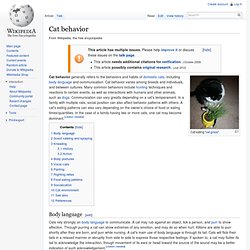
Cat behavior varies among breeds and individuals, and between cultures. Many common behaviors include hunting techniques and reactions to certain events, as well as interactions with humans and other animals, such as dogs. Communication can vary greatly depending on a cat's temperament. In a family with multiple cats, social position can also affect behavior patterns with others. A cat's eating patterns can also vary depending on the owner's choice of food or eating times/quantities. Body language[edit] Cats rely strongly on body language to communicate.
Scent rubbing and spraying[edit] This behavior is used primarily to claim ownership of something. KwrpyrEOFS1qan997o1_400.jpg (JPEG Image, 400 × 495 pixels) Portal:Cats. Cat. The domestic cat[1][2] (Felis catus[2] or Felis silvestris catus[4]) is a small, usually furry, domesticated, and carnivorous mammal.
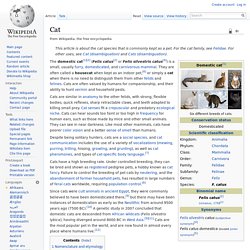
They are often called a housecat when kept as an indoor pet,[6] or simply a cat when there is no need to distinguish them from other felids and felines. Cultural depictions of cats. The cultural depiction of cats and their relationship to humans is as old as civilization and stretches back over 9,500 years.
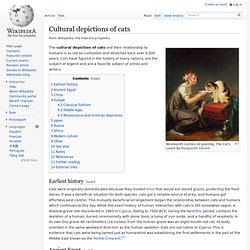
Cats have figured in the history of many nations, are the subject of legend and are a favorite subject of artists and writers. Earliest history[edit] Cats were originally domesticated because they hunted mice that would eat stored grains, protecting the food stores. It was a beneficial situation for both species: cats got a reliable source of prey, and humans got effortless pest control. This mutually beneficial arrangement began the relationship between cats and humans which continues to this day. Cats in ancient Egypt. A bronze statue of the cat goddess Bastet.
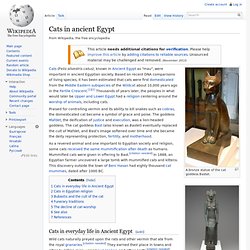
Seated Wadjet, 664 B.C.E. – 332 B.C.E. Bronze.Usually seen in the form of a cobra, the goddess Wadjet was depicted as a lion-headed woman in the later periods of Egyptian history. Brooklyn Museum Cats (Felis silvestris catus), known in Ancient Egypt as "mau", were important in ancient Egyptian society. Based on recent DNA comparisons of living species, it has been estimated that cats were first domesticated from the Middle Eastern subspecies of the Wildcat about 10,000 years ago in the Fertile Crescent.[1][2] Thousands of years later, the peoples in what would later be Upper and Lower Egypt had a religion centering around the worship of animals, including cats. Felinology.
Felinology is the study of cats.[1] The term has a Latin-Greek origin and comes from the Latin word felinus (of cats, feline) and the Greek -logos (science).
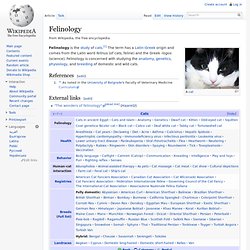
Cat health. Cat genetics. Cat genetics describes the study of inheritance as it occurs in domestic cats.
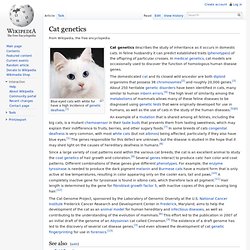
In feline husbandry it can predict established traits (phenotypes) of the offspring of particular crosses. In medical genetics, cat models are occasionally used to discover the function of homologous human disease genes. The domesticated cat and its closest wild ancestor are both diploid organisms that possess 38 chromosomes[2] and roughly 20,000 genes.[3] About 250 heritable genetic disorders have been identified in cats, many similar to human inborn errors.[4] The high level of similarity among the metabolisms of mammals allows many of these feline diseases to be diagnosed using genetic tests that were originally developed for use in humans, as well as the use of cats in the study of the human diseases.[5][6]
Cat coat genetics. This cat's coat allows it to blend in well with its environment The genetics of cat coat coloration, pattern, length, and texture is a complex subject, and many different genes are involved.
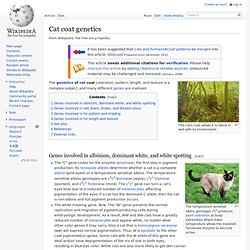
Genes involved in albinism, dominant white, and white spotting[edit] The temperature sensitive albino genotype cscs produces point coloration at body extremities where lower temperature allows the mutated Tyrosinase enzyme to become active. Genes involved in red, black, brown, and diluted colors[edit] This probably male cat shows the "red" O- genotype, with ll for long hair (though not show-quality), ss for absence of white spotting, and at least one Mc gene for the mackerel tabby pattern The sex-linked red gene, O, determines whether there will be red variations to fur color.[1] This gene is located on the X chromosome. A cat with Oo and white spotting genes is commonly called a calico. Rufous polygenes, as yet unidentified, can affect the richness of the orange/red gene's expression. M on forehead. Tabby cat. Common Mackerel tabby, with the striped pattern A tabby is any domestic cat that has a coat featuring distinctive stripes, dots, lines or swirling patterns, usually together with a mark resembling an M on its forehead.

Tabbies are sometimes erroneously assumed to be a cat breed.[1] In fact, the tabby pattern is found in many breeds, as well as among the general mixed-breed population. The tabby pattern is a naturally occurring feature that may be related to the coloration of the domestic cat's direct ancestor, the African Wildcat, which (along with the European Wildcat and Asiatic Wildcat) has a similar coloration. Tabby patterns[edit] Grey Classic tabby, showing the bullseye pattern Brown spotted tabby pattern on an Ocicat. Calico cat. A typical calico Calico cats are domestic cats with a spotted or parti-colored coat that is predominantly white, with patches of two other colors (often, the two other colors are orange tabby and black).

Outside of North America, the pattern is more usually called tortoiseshell-and-white. In the province of Quebec, they are sometimes called chatte d'Espagne (French for '(female) cat of Spain'). Other names include tricolor cat, mi-ke (Japanese for 'triple fur'), and lapjeskat (Dutch for 'patches cat'); calicoes with diluted coloration have been called calimanco or clouded tiger. Occasionally, the tri-color calico coloration is combined with a tabby patterning. Sister cats illustrating the difference between plain and "dilute" calico coats.